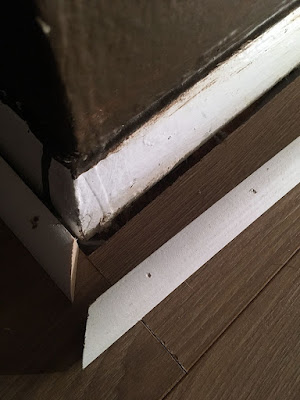Much like knowing when I walked into my house (!!!) that the light was going to be one of the best parts of living there, I knew right away that the dark brown living room wall was going to need to stop being dark brown.
 |
| Already dramatically improved. |
Now it's industrial chic instead. Paint will happen, but I'm not going to subject you to a single, mile-long post on a
wall. (Instead there will be two posts, because that's how I roll.)
 |
| The sad thing is, I don't think that's even close to the maximum number of shades of blue I've ever worn at once. |
Of course, first I had to pull the nails and screws still left in the walls from the prior owners. Don't ask why I'm not standing on the chair. I don't know.
 |
| I did contemplate whether or not I was risking death by cutting this. |
There are also old internet cables stapled and painted to the baseboards and walls all over the place, which look...bad. They're also completely unnecessary now, and no longer connected anyway, so I wriggled a screwdriver under one where it bent up to follow the wall, and pried it free. That was satisfying, although the amount of paint flaking wasn't very.
Also please not the double stacked quarter round against the existing baseboard. That's a heck of a lot of baseboarding, and it means I'm going to need to do some inventive things to hide the flooring gap when I replace it.
 |
| You lie. |
Yes, of course I pulled the baseboards.
Why make a project simple when you could add labor and expense?
I should have known when the quarter round popped off easily that getting the other baseboard off was going to entail some really significant work.
 |
| Confused yet? |
That's the first row of floorboards pulled up—as I thought, they're snap-together laminate, which makes getting them out of the way of recalcitrant baseboards that need to be
wrenched from place with a crowbar easier than it might have been otherwise.
 |
| AUGH |
I won, though not without a moment of great excitement when not just one, but two
Spiderum mysteriosum showed up. Behind the baseboard. Which I was levering away from the wall with my bare hands. I did not shriek, but retribution was swift and English.
 |
| I spy...a lot of dog fur, actually. |
I'm not entirely convinced any of that wall's internal bits actually contact the floor...anywhere. Obviously the hallway trim isn't attached to the wall at the corner, either. That's nice to know for future me, whenever I get around to changing out the carpet back there.
 |
| Not an approved use of your screwdrivers. |
I'm not a fan of the trim packed into the corners to seal the gaps between the plywood closet and the drywall, so I removed it. Now, of course, I need to seal or hide the gaps with something else, but I have some clever ideas for that.
 |
| Ready for an haute couture shoot. |
Most of the trim came off in little fragments, between the nails holding it down and being firmly glued in with silicon and thick layers of paint.
 |
| This is a daytime photo. It's really that color. |
Sanding! Sanding is pretty boring. You can make it less boring if you don't wear safety glasses while you're working above your head, because then the weird rolled up bits of super-thick paint the sandpaper is scritching off will fall into your eyes, and you will spend the rest of the evening wondering if acrylic wall paint is sharp enough to scratch corneas.
Not that I would know.










Comments
Post a Comment